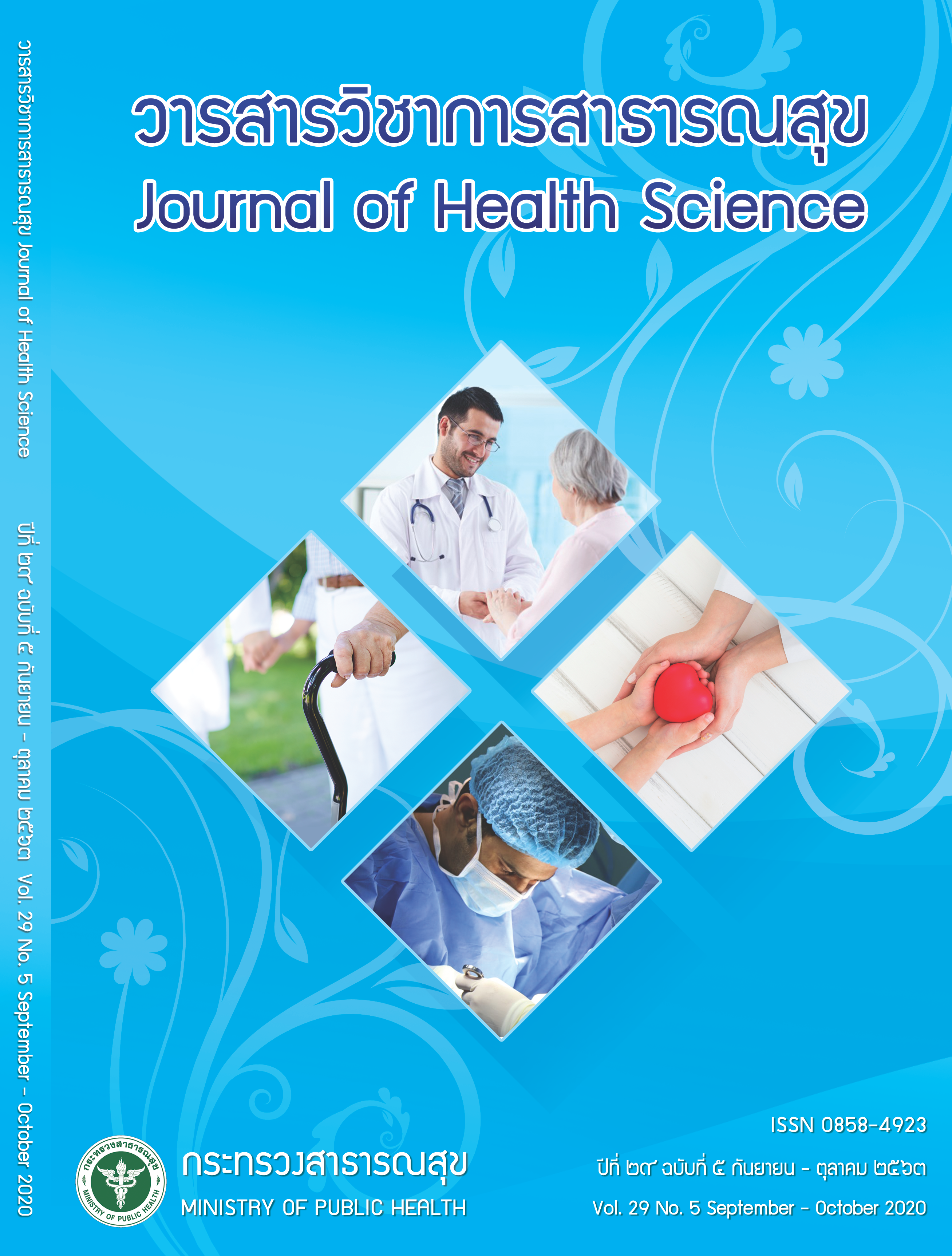Major Changes in Thai Diagnosis Related Group Version 6.2
Keywords:
diagnosis related group, diagnosis complexity level, normalization of relative weight, reduction in variance, explanatory power of hospital resource useAbstract
Thai Diagnosis Related Group (TDRG) is a patient classification system aiming to classify inpatients with similar clinical severity and hospital resource consumption in the same group. Thailand has used several versions of TDRG as a hospital inpatient payment tool starting with the National Health Security Office, then the Social Security Office and the Comptroller General’s Department, Ministry of Finance respectively. Three public insurance schemes have used TDRG version 5.1 since 2012, therefore TDRG should be updated to reflect new patterns of medical treatment and resource consumption. This paper presents results and major changes of TDRG version 6.2 compared with TDRG version 5.1. Major changes of TDRG version 6.2 comprised initial reclassification methodology by organizing several workshops with experts in many medical specialties exploring diagnosis complexity level in relationships with level of resource use in existing claim data. The iterative meetings with experts achieved higher correlation between evidence-based patient classification and hospital resource consumption. The final recalibration of TDRG version 6.2 adopted the normalization methodology to smoothen the untoward fluctuations of new relative weights (RW). Most statistics results showed better performance of TDRG version 6.2, despite the lower number of disease clusters in TDRG version 6.2 than TDRG version 5.1 (603 vs. 726 DCs), and lower number of DRGs (1,541 vs. 2,451 DRGs, a 910 reduction). TDRG version 6.2 achieved a higher reduction in variance (RIV) on standardized charge than TDRG version 5.1, suggesting that TDRG version 6.1 could classify better than the previous TDRG. In addition, relative weight of TDRG version 6.2 had higher explanatory power on hospital resource use than TDRG version 5.1. Furthermore, the adjusted RW could explain nearly 60% of total hospital resource use. In conclusion, TDRG version 6.2 better classified patients into the same groups with higher correlation to hospital resource use than TDRG version 5.1. The three public insurance schemes should adopt TDRG version 6.2 and determine appropriate base rates to pay for hospital inpatient care according to the adjusted RW of TDRG version 6.2.
Downloads
References
ศุภสิทธิ์ พรรณารุโณทัย. กลุ่มวินิจฉัยโรคร่วม: สถานการณ์และองค์ความรู้ในปี 2544. วารสารวิชาการสาธารณสุข 2544;11(5):569-81.
ศุภสิทธิ์ พรรณารุโณทัย. กลุ่มวินิจฉัยโรคร่วม:หลักการและใช้ประโยชน์. พิษณุโลก: ศูนย์วิจัยและติดตามความเป็นธรรมทางสุขภาพ คณะแพทยศาสตร์ มหาวิทยาลัยนเรศวร; 2542.
สำนักงานหลักประกันสุขภาพแห่งชาติ. คู่มือการจัดกลุ่มวินิจฉัยโรคร่วมและน้ำหนักสัมพัทธ์ ฉบับที่ 3 พ.ศ. 2545 เล่ม 1. นนทบุรี: สำนักงานหลักประกันสุขภาพแห่งชาติ; 2545.
สำนักงานหลักประกันสุขภาพแห่งชาติ. คู่มือการจัดกลุ่มวินิจฉัยโรคร่วมและน้ำหนักสัมพัทธ์ ฉบับที่ 4.0 พ.ศ. 2550 เล่ม 1. นนทบุรี: สำนักงานหลักประกันสุขภาพแห่งชาติ; 2550.
สำนักงานหลักประกันสุขภาพแห่งชาติ. Thai DRG version 5.0. นนทบุรี: สำนักงานหลักประกันสุขภาพแห่งชาติ; 2554.
Bredenkamp C, Bales S, Kahur K, (Editors). Transition to diagnosis-related group (DRG). Payments for health. Lessons from case studies. International Development in Focus. Washington DC: World Bank Group; 2020.
Australian Consortium for Classification Development. Development of the Australian refined diagnosis related groups V8.0 2014 [Internet]. [cited 2017 Jan 12]. Available from: https://www.ihpa.gov.au/publications/development-australian-refined-diagnosis-relat-ed-groups-v80
Jackson T, Dimitropoulos V, Madden R, Gillett S. Aus-tralian diagnosis related groups: drivers of complexity adjustment. Health Policy 2015;119(11):1433-41.
Loggie C. AR-DRG Version8.0: Implementation of episode clinical complexity model. HIM-INTER-CHANGE. 2016;6(1):25-7.
ศูนย์พัฒนากลุ่มโรคร่วมไทย (ศรท.) สถาบันวิจัยระบบสาธารณสุข (สวรส.). การจัดกลุ่มวินิจฉัยโรคร่วมไทยและน้ำหนักสัมพัทธ์ ฉบับ 6.2 เล่ม 1. นนทบุรี: สถาบันวิจัยระบบ-สาธารณสุข; 2560.
อรทัย เขียวเจริญ, ชัยโรจน์ ซึงสนธิพร, สุเมธี เชยประเสริฐ, ศุภสิทธิ์ พรรณารุโณทัย. ค่าน้ำหนักสัมพัทธ์สำหรับกลุ่มวินิจฉัยโรคร่วมประเทศไทย ฉบับ 6.2 วารสารวิชาการ-สาธารณสุข 2562;28(3):519-32.
Patient Classification Systems International. Statistic methods for casemix. Lisbon: PCS International; 2014.
Stausberg J, Kiefer E. Homogeneity of the German diagnosis-related groups. Health Serv Manage Res 2010;23(4):154-9.
BenTon PL, Evan H, Light SM, Mountney LM, Sanderson HF. The development of healthcare resource groups - version 3. Journal of Public Health Medicine 1998;20(3):351-8.
Reid B, Sutch S. Comparing diagnosis-related group system to identify design improvements. Health Policy 2008;87(1):82-91.
Independent Hospital Pricing Authority. National pricing model technical specification 2016-2017: Independent Hospital Pricing Authority [Internet]. 2016 [cited 2017 Jan 12]. Available from: https://www.ihpa.gov.au/sites/g/files/net636/f/publications/nep16_pricing_model_technical_specifications.pdf
Griffin N, Venables G, Jorda V. The casemix design framework - 2009 [Internet]. The Information Centre NHS; 2009 [cited 2017 Jan 12]. Available from: http://www.content.digital.nhs.uk/media/10810/Case-mix-Design-Framework-v23/pdf/Casemix-De-sign-Framework-v2.3.pdf
Downloads
Published
How to Cite
Issue
Section
License

This work is licensed under a Creative Commons Attribution-NonCommercial-NoDerivatives 4.0 International License.







